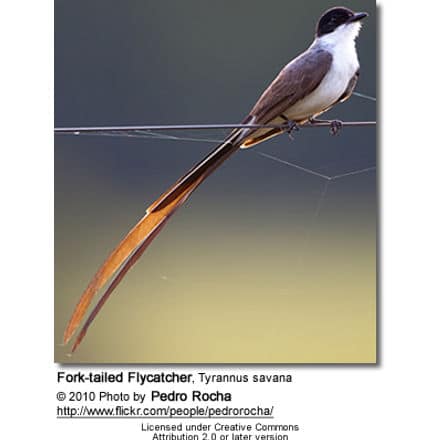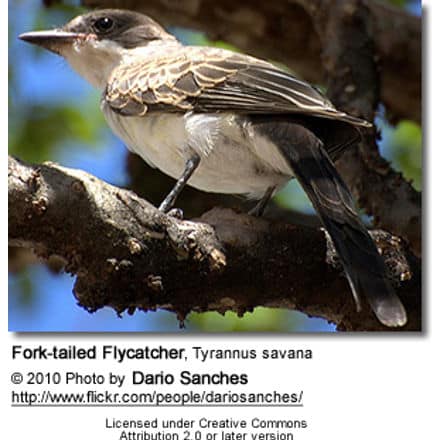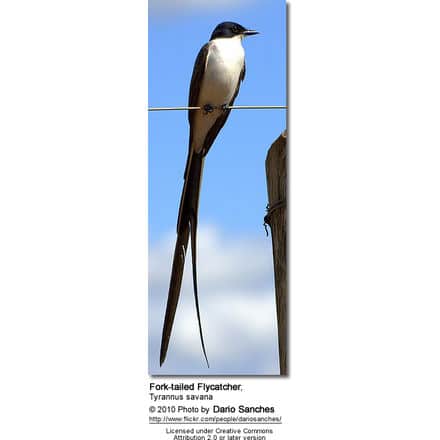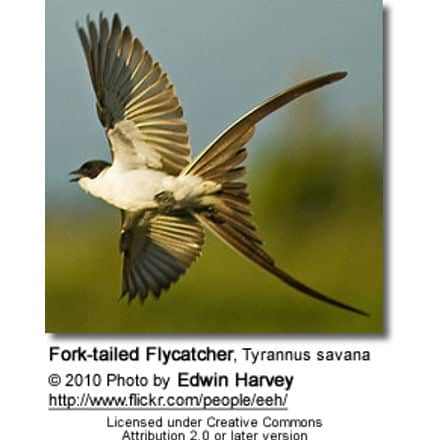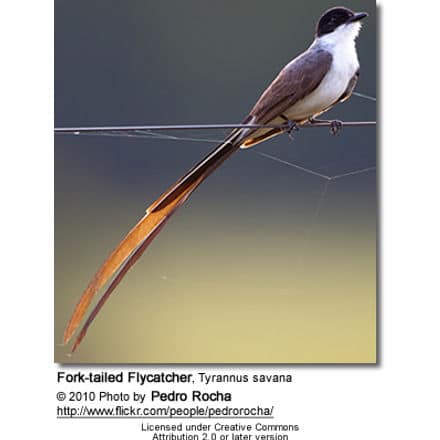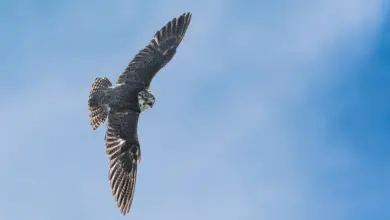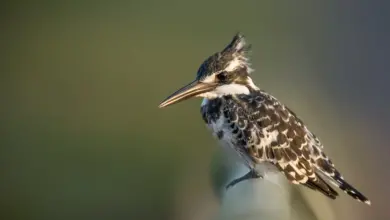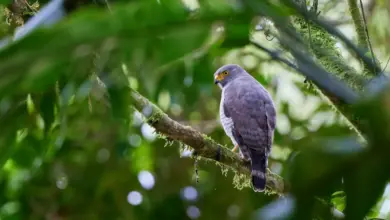Fork-tailed Flycatchers
The Fork-tailed Flycatchers or Fork-tailed Kingbirds (Tyrannus savana) are part of the tyrant flycatcher family and members of the kingbirds. They are named for the male’s spectacular long and deeply forked tail feathers and their foraging habit – of catching flies (or other insects) “on the wing” (in flight).

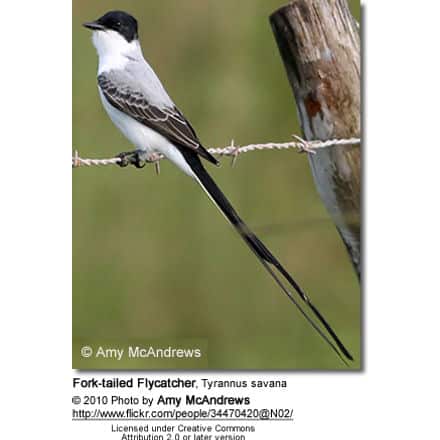
Distribution
They are widespread in most of their range, from Mexico south to central Argentina (Rio Negro, with a few recent records south to northeastern Chubut).
Vagrants occur in the eastern United States seaboard, as far north as Canada.
They are both migratory and resident, depending on their range.
They breed from central Mexico to central Argentina where they are typically resident (non-migratory).
Those occurring in the southern parts travel northward for the austral winter (from March to September).
During the migration, they can form large, loose flocks with thousands or even more of them resting at favored roosting sites.
They are native to the following countries:
North America: Mexico
Central America: Belize, Costa Rica, Guatemala, Honduras, Nicaragua, Panama
Caribbean countries / islands: Aruba, Netherlands Antilles, Trinidad and Tobago
South America: Argentina, Bolivia, Brazil, Chile, Colombia, Ecuador, French Guiana, Guyana, Paraguay, Peru, Suriname, Uruguay, Venezuela
They are vagrants (non-breeding visitors) to:
North America: Canada, United States
Northwestern Atlantic Ocean (near Canada): Saint Pierre and Miquelon
Caribbean countries / islands: Antigua and Barbuda, Barbados, Bermuda, Caymand Islands, Cuba, Dominica, Grenada, Jamaica, Martinique, Montserrat, Saint Lucia, Saint Martin (French part), Saint Vincent and the Grenadines, Saint Kitts and Nevis
South Atlantic Ocean: Falkland Islands (Malvinas);
Habitat
They occur in a wide range of habitats, including riparian forests, savannas, open residential areas and pastures with scattered trees or low bushes.

Subspecies and Ranges:
- Tyrannus savana savana (Vieillot, 1808)
- Native to central, south and southeastern Brazil (Rondônia and southern Mato Grosso east to Tocantins and southern Piauí, south to Mato Grosso do Sul, Minas Gerais, Rio de Janerio and Rio Grande do Sul), northern and eastern Boliva, Paraguay, Argentina – south to Río Negro, sometimes to northeastern Chubut and Patagonia) and Uruguay.
- Tyrannus savana monachus (Hartlaub, 1844)
- Range: Southern Mexico (central and southern Veracruz, northern Oaxaca, northeastern Chiapas, Tabasco, southwestern Campeche) south to Colombia (except the northern parts, but generally east of Andes south to Meta and Vichada) and much of Venezuela and several offshore islands. Also found in southern Surinam (Sipaliwini) and northcentral Brazil.
- Tyrannus savana sanctaemartae (J. T. Zimmer, 1937)
- Range: Northern Colombia – along the Caribbean coastal region and Santa Marta mountains region – and extreme northwestern Venezuela in northwestern Zulia.
- Tyrannus savana circumdatus (J. T. Zimmer, 1937)
- Range: Northern Brazil in the eastern Amazonas (occasionally west to Manaus) and Pará and Amapá (southern bank of the Amazonas Rivers, the islands near Santarém, and both banks of the Tapajós river).
Description
Male Fork-Tailed Flycatchers are generally larger than females, measuring about 37 – 41 cm in length (including the tail), the female measures 28 – 30 cm in length. They weigh between 28 – 32 g.
The plumage is pale grey above with a black cap and white below.
Males sometimes have a yellow crown stripe atop their black cap. Males can most easily be identified by their long, double-forked tail feathers, which are somewhat shorter in females and significantly shorter in juveniles. The male’s tail feathers are shorter when molting (as new tail feathers grow in).
Immatures have brownish-colored heads.
The different subspecies can be identified by the differing pattern of the notches of their outer flight feathers.
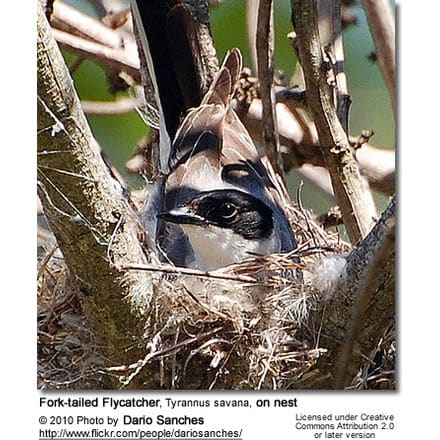
Breeding / Nesting
Fork-tailed Flycatchers build shallow cup nests with plant fibers, grasses, leaves and bark shreds, lined with down, soft plant fibers and hair. The nest is usually situated 1–10 m high in a shrub or short tree.
The average clutch consists of 2 – 3 white eggs with brown and lavender spots. The female alone incubates the eggs for about 14 – 17 days. The young fledge (leave the nest) when they are about 13 – 16 days old.
Diet / Feeding
During the summer, they will mostly feed on insects, and during the winter, when insects become scarce, they will switch to fruits and berries.
Alternate (Global) Names
Danish: Langhalet Kongetyran … Dutch: Vorkstaartkoningstiran, Vorkstaart-koningstiran … German: Gabelschwanz-Königstyrann, Gabeltyrann, Gabel-Tyrann, Gabel Tyrann … Spanish: Cazamoscas tijereta, Cola Ahorquillada, Pitirre Sabanero, Sirirí Tijeretón, Tijereta, Tijereta cabecinegra, Tijereta Común, Tijereta Sabanera, Tirano-tijereta Gris, Tirano-tijereta Sabanero … Italian: Pigliamosche codaforcuta, Tiranno codaforcuta meridionale … Japanese: zuguroembitairanchou, zuguroenbitairanchou … Norwegian: Gaffeltyrann … Polish: tyran widlosterny, tyran wid?osterny … Russian: ??????????? ??????????? ??????, ??????????? ???????, ??????????? ????? … Slovak: postriežkár lastovicí, Tyran lastovi?kovitý … Swedish: Gaffelstjärtstyrann


The Fork-tailed Flycatchers, Tyrannus savana, is a passerine bird of the tyrant flycatcher family, and is the member of a genus typically referred to as kingbirds.
Distribution
This bird occurs in a wide variety of habitats including pastures, riparian forests, and open residential areas with scattered trees. Its breeding range is from central Mexico to central Argentina.
In most of this range it is usually found year-round, but in the southern parts of its range it retreats northward for the winter. This species is also known to wander widely.
It occurs almost annually in the eastern United States seaboard and Canada.
Description and ecology
The Fork-tailed Flycatchers is white below, gray above and has a black cap. Males sometimes show a yellow crown stripe. Males also have an extremely long forked tail, even longer than that of their cousin, the Scissor-tailed Flycatcher.
Females have a somewhat shorter tail, while it is significantly shorter in juveniles.
Males are 37–41 cm in length; females, 28–30 cm, including tail. It weighs 28–32 g.

Breeding / Nesting
This flycatcher builds a shallow cup nest 1–10 m high in a shrub or short tree. Females normally lay 2 or 3 eggs.
Diet / Feeding
This species is primarily an insectivore, but will switch to berries and small fruits during winter if insects become scarce.

